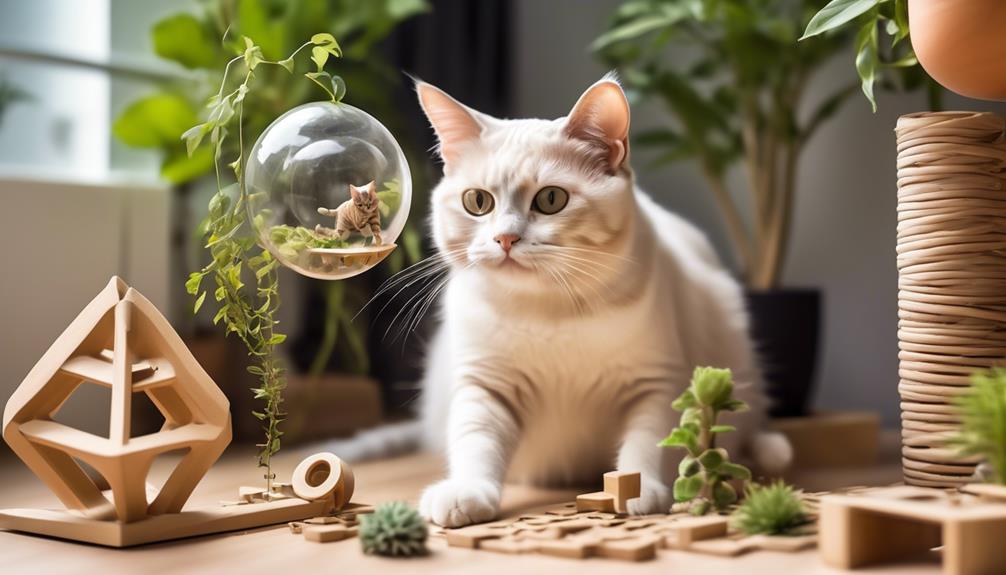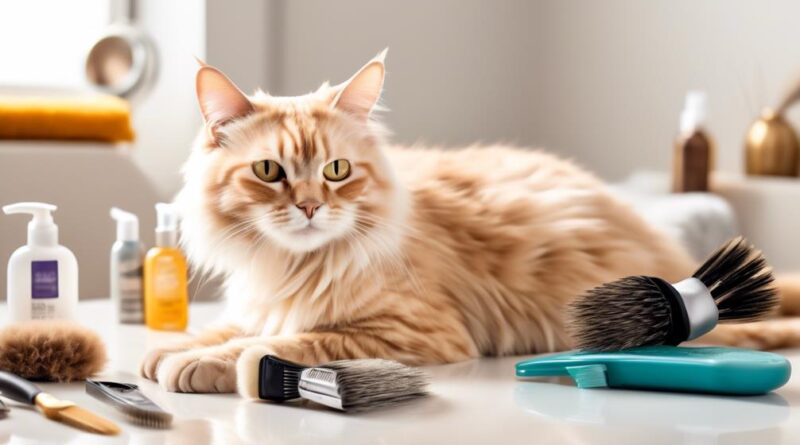10 Tricks to Minimize Hairballs in Cats
Tired of finding those unsightly hairballs around your home, but uncertain how to prevent them without resorting to extreme measures?
There are simple and effective tricks you can implement to minimize hairballs in your feline friend.
These tips not only reduce the inconvenience of cleaning up after your cat but also contribute to their overall health and well-being.
Regular Brushing
Regular brushing is essential for minimizing hairballs in your cat. Not only does it help with shedding control, but it also contributes to maintaining your cat's coat health. By brushing your cat regularly, you can remove loose fur, preventing it from being ingested during self-grooming and reducing the likelihood of hairballs. Additionally, brushing helps distribute natural oils throughout the coat, keeping it healthy and reducing the amount of hair your cat ingests while grooming.
To effectively control shedding, establish a consistent brushing routine. Short-haired cats may require weekly brushing, while long-haired breeds may need more frequent sessions. Use a brush or comb specifically designed for your cat's coat type to ensure that you're effectively removing loose fur and preventing matting. Remember to be gentle, especially around sensitive areas, and make the experience enjoyable for your cat by offering treats and praise.
Incorporating regular brushing into your cat's grooming routine not only minimizes hairballs but also promotes overall coat health. It helps in the removal of dirt, debris, and loose fur, preventing tangles and mats that can lead to excessive shedding and discomfort for your cat. By investing time in regular brushing, you contribute to your cat's well-being and reduce the chances of hairball-related issues.
High-Fiber Diet
A high-fiber diet can significantly aid in reducing the formation of hairballs in your cat. By incorporating dietary supplements and fiber-rich treats into your cat's daily meals, you can help prevent the accumulation of hair in their digestive system. These supplements are specially formulated to promote healthy digestion and reduce hairball formation. Look for supplements that contain natural ingredients such as psyllium or oat fiber, which can help move hair through the digestive tract more effectively.
In addition to dietary supplements, consider offering fiber-rich treats to your cat. These treats can provide an extra boost of fiber to support digestive health and minimize hairball formation. When choosing treats, opt for those that are specifically designed to support hairball control, as they often contain higher levels of fiber and other beneficial ingredients.
When introducing dietary changes, it's important to do so gradually, as sudden changes in a cat's diet can lead to digestive upset. Start by mixing small amounts of the new high-fiber food or treats with your cat's regular diet, and gradually increase the proportion over the course of a week or two. This will allow your cat's digestive system to adjust to the new diet and minimize the risk of any negative reactions.
Hydration
To ensure your cat's optimal health and minimize hairball formation, maintaining proper hydration is crucial. Adequate water consumption is essential for preventing hairballs in cats. Here are some tips to ensure your feline friend stays hydrated:
- Water Consumption
Encourage your cat to drink more water by providing clean, fresh water in multiple locations throughout your home. Cats prefer running water, so consider investing in a cat fountain to pique their interest and increase water intake.
Monitor your cat's water intake to ensure they're consuming enough. If you notice decreased water consumption, it could be a sign of an underlying health issue, and you should consult your veterinarian.
- Wet Food
Incorporate wet food into your cat's diet as it has a higher moisture content compared to dry kibble. The extra hydration from wet food can help prevent hairballs by aiding in the passage of hair through the digestive system.
Consider mixing water into your cat's wet food to further increase their moisture intake. This can be especially beneficial for cats who are reluctant to drink water from a bowl.
Hairball Remedies
As a cat owner, you can help alleviate hairballs by incorporating specific remedies into your feline's routine. Natural supplements such as coconut oil or fish oil can help lubricate your cat's digestive tract, making it easier for hair to pass through their system. These supplements can be added to your cat's food, following the recommended dosage based on your veterinarian's advice.
Additionally, providing your cat with homemade remedies like pumpkin puree can add fiber to their diet, aiding in the digestion and passage of hair through the gastrointestinal tract.
Another natural supplement that can aid in reducing hairballs is aloe vera juice. Aloe vera juice can help soothe the digestive tract and promote healthy bowel movements, reducing the likelihood of hairball formation. It's important to note that aloe vera juice should be given in small amounts and be free of any additives or preservatives.
Incorporating these natural supplements and homemade remedies into your cat's routine can help minimize the occurrence of hairballs. However, it's essential to consult with your veterinarian before introducing any new supplements or remedies to your cat's diet. Monitoring your cat's behavior and overall health can also help you determine the effectiveness of these remedies in reducing hairballs.
Stress Reduction
Incorporate stress reduction techniques into your cat's routine to help minimize the occurrence of hairballs. Cats can experience anxiety and stress, which may lead to excessive grooming and hairball formation. By implementing stress management strategies, you can help your feline friend maintain a healthier coat and reduce hairballs.
- Create a Calm Environment
- Provide your cat with a quiet and safe space where they can retreat to when feeling stressed.
- Use pheromone diffusers or sprays to create a soothing atmosphere, helping to alleviate anxiety in your cat.
- Interactive Playtime
- Engage your cat in regular interactive play sessions to provide mental stimulation and physical exercise, which can reduce stress and anxiety.
- Offer a variety of toys to keep your cat entertained and mentally engaged, promoting overall well-being and minimizing stress-related grooming.
Grooming Tools
You can effectively minimize hairballs in your cat by using appropriate grooming tools that help manage shedding and prevent excessive grooming. Shedding control is crucial in preventing hairballs. Regular brushing with a deshedding tool can help remove loose fur, reducing the amount your cat ingests while grooming. Look for a deshedding tool specifically designed for cats, as it can effectively minimize shedding by reaching deep into the undercoat to remove loose hair. This not only reduces the amount of fur your cat swallows but also prevents fur matting.
Fur matting can lead to excessive grooming, causing your cat to ingest more fur and consequently increasing hairball formation. A slicker brush is an excellent tool for preventing fur matting. It helps remove tangles and prevents the fur from becoming matted, reducing the need for your cat to excessively groom itself. Regular use of a slicker brush can significantly decrease the amount of loose fur your cat swallows, ultimately minimizing hairballs.
In addition to brushes, consider using grooming wipes to keep your cat's fur clean and reduce shedding. These wipes can help remove loose fur and dander, further preventing your cat from ingesting excessive amounts of fur. When using grooming tools, be gentle and patient with your cat to make the grooming experience pleasant and stress-free.
Regular grooming with appropriate tools can go a long way in minimizing hairballs and keeping your cat healthy and comfortable.
Environmental Enrichment

To enhance your cat's well-being and minimize hairballs, consider enriching their environment with stimulating activities and resources.
Environmental enrichment is crucial for keeping your cat mentally and physically engaged, reducing stress, and preventing excessive grooming that can lead to hairballs. Here are some effective ways to achieve this:
- Interactive toys: Providing interactive toys can keep your cat entertained and mentally stimulated. Toys such as puzzle feeders, laser pointers, and feather wands can encourage your cat to move around and engage in natural hunting behaviors, which can help minimize stress and decrease the likelihood of excessive grooming.
- Puzzle feeders: These toys dispense small amounts of food when manipulated, encouraging your cat to 'hunt' for their meals, which can reduce anxiety and prevent over-grooming.
- Feather wands: Interactive playtime with feather wands can redirect your cat's energy towards pouncing and chasing, providing mental stimulation and physical activity while reducing the likelihood of hairball-inducing grooming.
- Vertical space: Cats are natural climbers and providing vertical space can offer them opportunities to explore and observe their environment from above. Cat trees, wall shelves, and window perches are great options to create vertical territory for your cat, promoting exercise and reducing stress by allowing them to survey their surroundings.
Veterinary Consultation
Consider scheduling a veterinary consultation to address any underlying health issues that may contribute to your cat's hairball problems. A veterinarian can assess your cat's overall health and determine if there are any underlying conditions that may be exacerbating hairball formation. Preventive measures, such as regular grooming and dietary adjustments, can be discussed during the consultation. Your veterinarian can recommend specific grooming techniques to minimize shedding and hair ingestion, as well as suggest dietary changes that may help reduce hairball formation.
During the veterinary consultation, your veterinarian may recommend incorporating more fiber into your cat's diet. This can help move hair more efficiently through the digestive system, reducing the likelihood of hairballs. Additionally, they may suggest specialized cat foods designed to support hairball control. These foods often contain specific ingredients to aid in digestion and the passage of hair through the gastrointestinal tract.
Furthermore, the veterinarian may conduct a thorough physical examination to check for any skin conditions or gastrointestinal abnormalities that could be contributing to excessive shedding or hairball issues. They can also provide guidance on the frequency and techniques for at-home grooming to minimize the amount of hair your cat ingests during self-grooming.
Frequently Asked Questions
Are Certain Breeds of Cats More Prone to Hairballs Than Others?
Common misconceptions suggest that certain breeds of cats are more prone to hairballs due to genetic predisposition. However, all cats can experience hairballs. Regular grooming, a balanced diet, and access to fresh water can help minimize them.
Can Hairballs Cause Any Serious Health Issues for Cats?
Hairball prevention is vital for your cat's health. While hairballs may cause digestive issues or blockages, dietary changes and regular grooming techniques can minimize these risks. Keep an eye on your cat's health and take preventative measures.
How Often Should I Bathe My Cat to Help Reduce Hairballs?
To help reduce hairballs, bathe your cat every 1-2 months. Regular grooming, like brushing, can also help manage shedding. Consistent care of your cat's coat will lessen the amount of loose hair they ingest, reducing hairball formation.
Can I Give My Cat Human Hairball Remedies, Such as Petroleum Jelly or Mineral Oil?
You should avoid giving your cat human hairball remedies like petroleum jelly or mineral oil. Instead, focus on proper cat grooming and using feline-specific hairball prevention products to promote your cat's health and well-being.
Are There Any Natural Supplements That Can Help Prevent Hairballs in Cats?
You can help prevent hairballs in cats using natural remedies like dietary changes. Adding fiber-rich foods and supplements like pumpkin or coconut oil can aid in digestion, reducing hairball formation. It's a simple and effective way to minimize hairball issues.
Conclusion
So, there you have it! By incorporating regular brushing, a high-fiber diet, and promoting hydration, you can help minimize hairballs in your feline friend.
Don't forget to provide environmental enrichment, reduce stress, and consult with your vet for additional advice.
With these tricks up your sleeve, you'll be able to keep your cat happy, healthy, and hairball-free!
